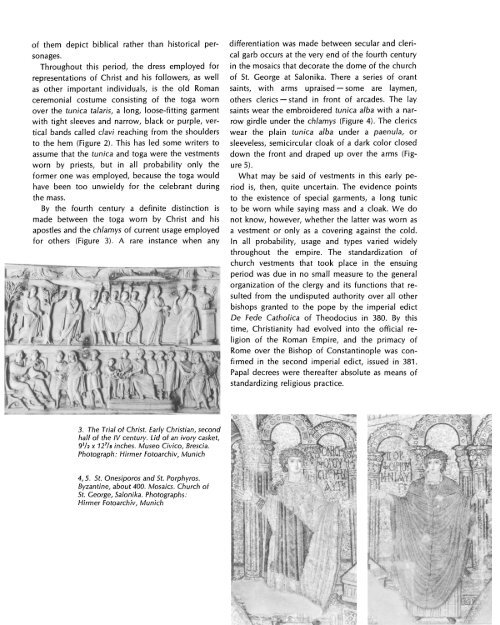The Metropolitan Museum of Art Bulletin, v. 29, no. 7 (March, 1971)
The Metropolitan Museum of Art Bulletin, v. 29, no. 7 (March, 1971)
The Metropolitan Museum of Art Bulletin, v. 29, no. 7 (March, 1971)
You also want an ePaper? Increase the reach of your titles
YUMPU automatically turns print PDFs into web optimized ePapers that Google loves.
<strong>of</strong> them depict biblical rather than historical personages.<br />
Throughout this period, the dress employed for<br />
representations <strong>of</strong> Christ and his followers, as well<br />
as other important individuals, is the old Roman<br />
ceremonial costume consisting <strong>of</strong> the toga worn<br />
over the tunica talaris, a long, loose-fitting garment<br />
with tight sleeves and narrow, black or purple, vertical<br />
bands called clavi reaching from the shoulders<br />
to the hem (Figure 2). This has led some writers to<br />
assume that the tunica and toga were the vestments<br />
worn by priests, but in all probability only the<br />
former one was employed, because the toga would<br />
have been too unwieldy for the celebrant during<br />
the mass.<br />
By the fourth century a definite distinction is<br />
made between the toga worn by Christ and his<br />
apostles and the chlamys <strong>of</strong> current usage employed<br />
for others (Figure 3). A rare instance when any<br />
differentiation was made between secular and clerical<br />
garb occurs at the very end <strong>of</strong> the fourth century<br />
in the mosaics that decorate the dome <strong>of</strong> the church<br />
<strong>of</strong> St. George at Salonika. <strong>The</strong>re a series <strong>of</strong> orant<br />
saints, with arms upraised--some are laymen,<br />
others clerics--stand in front <strong>of</strong> arcades. <strong>The</strong> lay<br />
saints wear the embroidered tunica alba with a narrow<br />
girdle under the chlamys (Figure 4). <strong>The</strong> clerics<br />
wear the plain tunica alba under a paenula, or<br />
sleeveless, semicircular cloak <strong>of</strong> a dark color closed<br />
down the front and draped up over the arms (Figure<br />
5).<br />
What may be said <strong>of</strong> vestments in this early period<br />
is, then, quite uncertain. <strong>The</strong> evidence points<br />
to the existence <strong>of</strong> special garments, a long tunic<br />
to be worn while saying mass and a cloak. We do<br />
<strong>no</strong>t k<strong>no</strong>w, however, whether the latter was worn as<br />
a vestment or only as a covering against the cold.<br />
In all probability, usage and types varied widely<br />
throughout the empire. <strong>The</strong> standardization <strong>of</strong><br />
church vestments that took place in the ensuing<br />
period was due in <strong>no</strong> small measure to the general<br />
organization <strong>of</strong> the clergy and its functions that resulted<br />
from the undisputed authority over all other<br />
bishops granted to the pope by the imperial edict<br />
De Fede Catholica <strong>of</strong> <strong>The</strong>odocius in 380. By this<br />
time, Christianity had evolved into the <strong>of</strong>ficial religion<br />
<strong>of</strong> the Roman Empire, and the primacy <strong>of</strong><br />
Rome over the Bishop <strong>of</strong> Constanti<strong>no</strong>ple was confirmed<br />
in the second imperial edict, issued in 381.<br />
Papal decrees were thereafter absolute as means <strong>of</strong><br />
standardizing religious practice.<br />
3. <strong>The</strong> Trial <strong>of</strong> Christ. Early Christian, second<br />
half <strong>of</strong> the IV century. Lid <strong>of</strong> an ivory casket,<br />
91/2 x 127/8 inches. Museo Civico, Brescia.<br />
Photograph: Hirmer Fotoarchiv, Munich<br />
4, 5. St. Onesiporos and St. Porphyros.<br />
Byzantine, about 400. Mosaics. Church <strong>of</strong><br />
St. George, Salonika. Photographs:<br />
Hirmer Fotoarchiv, Munich

















